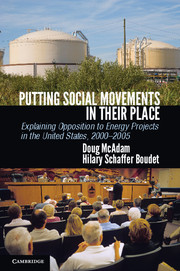 Putting Social Movements in their Place
Putting Social Movements in their Place Published online by Cambridge University Press: 05 June 2012
In Chapter 1, we spelled out four principal research questions that we hoped to address in the book: How much emergent collective action do we see across the twenty communities we are studying? What causal conditions explain variation in the level of mobilization in these communities? Net of other factors, what influence, if any, does the level of mobilized opposition have on the outcome of the proposed project? Finally, why did opposition to one kind of energy project – liquefied natural gas (LNG) terminals – grow into broader regional movements in some parts of the country but not others? In this chapter, we take up the first two of these questions. We aim to establish something of a baseline of just how much emergent collective action we see across the twenty communities we are studying and then move to see if we can identify certain mixes of factors – or “recipes” in the language of fuzzy set/Qualitative Comparative Analysis (fs/QCA) – that help account for variation in level of mobilization across these locales. We begin with a basic description of the level and forms of emergent collective action we found in the twenty communities that we have come to know so well throughout the past few years.
ESTABLISHING A BASELINE
A newcomer to the United States would be forgiven if, in reading the social movement literature, she or he imagined that our communities were awash in protest activity. In a 2005 article, McAdam and colleagues (2005: 2) argued that the field’s initial engagement with and continued interest in the movements of the 1960s had “created a stylized image of movements that threatens to distort our understanding of popular contention . . . in the contemporary U.S. . . . This stylized view tends to equate movements with:
Disruptive protest in public settings
Loosely coordinated national struggles over political issues
Urban and/or campus-based protest activities
Claim making by disadvantaged minorities.”
To save this book to your Kindle, first ensure [email protected] is added to your Approved Personal Document E-mail List under your Personal Document Settings on the Manage Your Content and Devices page of your Amazon account. Then enter the ‘name’ part of your Kindle email address below. Find out more about saving to your Kindle.
Note you can select to save to either the @free.kindle.com or @kindle.com variations. ‘@free.kindle.com’ emails are free but can only be saved to your device when it is connected to wi-fi. ‘@kindle.com’ emails can be delivered even when you are not connected to wi-fi, but note that service fees apply.
Find out more about the Kindle Personal Document Service.
To save content items to your account, please confirm that you agree to abide by our usage policies. If this is the first time you use this feature, you will be asked to authorise Cambridge Core to connect with your account. Find out more about saving content to Dropbox.
To save content items to your account, please confirm that you agree to abide by our usage policies. If this is the first time you use this feature, you will be asked to authorise Cambridge Core to connect with your account. Find out more about saving content to Google Drive.